A nuclear submarine beneath the Arctic ice cap and a sundial on Mars are two of the more unusual research projects presently being funded in the US. The 8 centimetre high sundial is inscribed with the motto "Two Worlds, One Sun" and will travel to Mars on NASA's Mars Surveyor 2001 mission. Cameras on the spacecraft will send pictures of the sundial back to Earth. The sundial does have one serious purpose: the multi-coloured tiles on its surface will help calibrate the cameras, which will also be used for scientific purposes. Meanwhile the USS Hawkbill has left port on the fifth joint scientific mission between the National Science Foundation and the US Navy to study changes in the arctic environment.

The aluminium sundial features rings representing the orbits of Mars and Earth, and red and blue dots showing the position of the two planets at the time of the landing. Once safely installed on Mars, the sundial will relay local Martian time to a Web-site. And in a week in which Germany hosted a conference on space tourism, the designers have made allowances for tourists from all over the globe – the sundial carries the name of Mars in 44 languages.
Science submarines
Meanwhile the Hawkbill submarine will deploy a sophisticated new sonar system to map oceanic ridges and basins on the floor of the Arctic Ocean. Researchers on the project hope to discover how extensive the last ice age was by looking for glacial scouring off the Alaskan coast, and to measure underwater volcanic activity off the Gakkel oceanic ridge. They will also enter Norwegian waters to study circumpolar currents.




